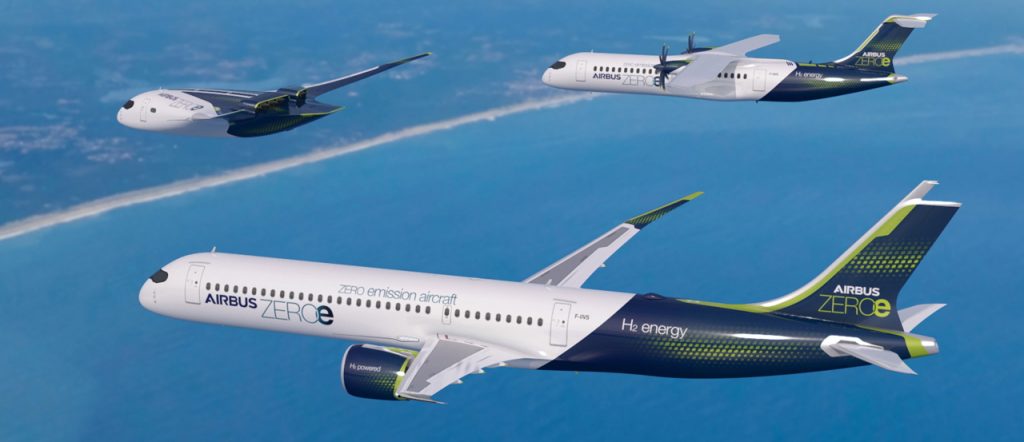Aviation pulls out all the stops to fly greener
Edition #2 2021*
Text: Klaas-Jan van Woerkom
Image: Airbus
"Emission-free aviation is not a utopia," easyJet chief Johan Lundgren stated at the Airbus Summit in Toulouse. There, late last month, there was plenty of discussion of ways to make aviation more sustainable, and preferably as soon as possible.
Flying without burdening the environment seems an impossible task. Yet the airborne sector is meeting that challenge, hounded by ambitious climate goals from government and the industry itself. "It's a strategic interplay between technology and regulation," is how Lundgren concretely summarizes the current state of affairs. "Global aviation continues to grow, but we need to be at zero CO2 emissions by 2050 at the latest. We need to work with all stakeholders toward that."

No time to lose
"The year 2035 is just around the corner tomorrow, so to speak, so we need to speed up," Airbus chief executive Guillaume Faury told the assembled aviation experts, media and bloggers. "However, it is a complex task that we have to take on collectively. In this, the corona crisis should not be an inhibiting factor, we have no excuse to wait. "Airbus itself has several ideas for moving quickly toward more sustainable aviation.
The European aircraft manufacturer late last year launched the ambitious ZEROe project, which refers to "zero emission" being sought. As part of the program, three new aircraft types are being developed that use hydrogen as fuel, instead of kerosene.
For example, work is underway on an aircraft similar to the current A320, which should be able to carry 120 to 200 passengers over a distance of 3,700 kilometers. There should also be a turboprop for up to 100 passengers, capable of flying 1,750 kilomer miles, as a sustainable alternative to the current ATR series offered by Airbus. The third aircraft looks the most revolutionary: a flying wing in which fuselage and wing merge and which should accommodate 200 passengers and have a flight range of 3,700 kilometers.
Airbus proclaimed last year that the first aircraft should be able to fly as early as 2035. When asked, top executive Faury states he is confident that that year is feasible. However, mass production need not be expected. "The technology needed is still in development iin full swing, the application of hydrogen has to be approved by regulatory authorities and - perhaps most importantly - hydrogen has to be available at all major airports, at a competitive price." The latter appears to be the biggest challenge. The production of hydrogen for aviation is costly and is actually still in its infancy.

Sustainable fuel
As an interim solution, the aviation industry relies for now on so-called SAF, or Sustainable Aviation Fuel. That's fuel brewed from agricultural waste or used cooking oil, among other things. Some countries are considering or already have a blending requirement that would require airlines to use SAF in the future. This also has the disadvantage that its production is still limited. "Moreover, it is four to five times more expensive than regular kerosene," says Lundgren, who is not an avid user of the fuel with easyJet.
Accordingly, the industry again sounded the call for governments to encourage the production of SAF, in part by investing the proceeds of aviation taxes in production facilities for biological or synthetic fuel. "The infrastructure is already there, as SAF can be pumped through the same pipes as kerosene," said, Heathrow chief executive John Holland-Kaye.
Short routes
Airbus recently launched a collaboration with Air France and French air traffic control to test optimal flight paths within France to demonstrate that such a thing is workable. Under the project name Albatross, trials will be conducted in 2021 and 2022 on a thousand commercial passenger flights, which will not only fly shorter routes, but also climb and descend more optimally as well as use poor one engine during taxiing. Sustainable fuel will also be used in the process.
According to captain Laurent Lafontan, SVP Flight Operations, Air France can save tens of thousands of tons of CO2 emissions annually through these new procedures. Later, Wizz Air and SWISS will also be involved in the project.
CityAirbus
Airbus also took advantage of the Toulouse meeting to unveil the CityAirbus, an innovative, autonomously flying air cab that most closely resembles a large-scale drone. The electrically powered aircraft, with a maximum speed of 80 kilometers per hour and a flight range of 120 kilometers, will replace regular cabs and helicopters in urban transport from 2025.
This article was produced in collaboration with Aviation News Magazine.
*Curious about the full Traveletc. edition? Then you can download this here view!